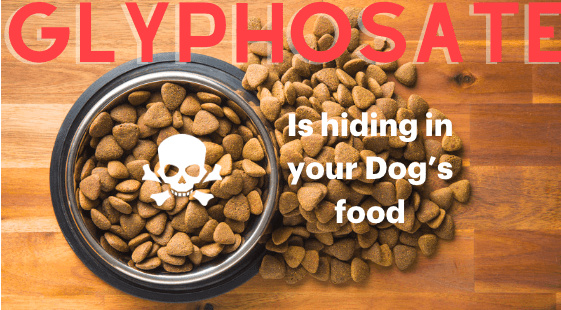Glyphosate is in your dog's kibble and it's a problem. Glyphosate, aka roundup is the most commonly used herbicide that is used as a weedkiller. It is used on most common crops including corn, soybeans, oats, wheat, sugar beets, canola which are the bulk of ingredients in kibble.
Let's take a look at a popular kibble brand, Purina. Purina ONE Smartblend Chicken & Rice Dry Dog Food ingredients are listed below.
Chicken (Source Of Glucosamine), Rice Flour, Corn Gluten Meal, Whole Grain Corn, Chicken By-Product Meal (Source Of Glucosamine), Whole Grain Wheat, Soybean Meal, Beef Fat Naturally Preserved With Mixed-Tocopherols, Glycerin, Liver Flavor, Calcium Carbonate, Mono And Dicalcium Phosphate, Salt, Caramel Color, Dried Carrots, Dried Peas, Potassium Chloride, Vitamins [Vitamin E Supplement, Niacin (Vitamin B-3), Vitamin A Supplement, Calcium Pantothenate (Vitamin B-5), Thiamine Mononitrate (Vitamin B-1), Vitamin B-12 Supplement, Riboflavin Supplement (Vitamin B-2), Pyridoxine Hydrochloride (Vitamin B-6), Folic Acid (Vitamin B-9), Menadione Sodium Bisulfite Complex (Vitamin K), Vitamin D-3 Supplement, Biotin (Vitamin B-7)], Minerals [Zinc Sulfate, Ferrous Sulfate, Manganese Sulfate, Copper Sulfate, Calcium Iodate, Sodium Selenite], Choline Chloride, L-Lysine Monohydrochloride, Sulfur. X-4154.
This entire ingredient list is concerning, but when it comes to glyphosate, anything highlighted in red has absolutely been sprayed with it and if your dog eats this kibble, then they are eating glyphosate too. No question. The ingredients used in this particular blend are common and used is most brands. Glyphosate is in your dog's kibble and it is a problem.
Kibble is a huge business that is worth billions of dollars. Businesses make money by selling a product for the most they can while making it for the cheapest possible price they can. This is where cheap ingredients come to play. The cheapest ingredients like corn, soybeans, oats, wheat, sugar beets, canola are protected by glyphosate to keep the ingredients in tact during mass production of kibble with absolutely no regard for the health of your animal.
So, if your dog eats kibble regularly, they are most likely consuming glyphosate as well. It's also no coincidence that disease rates are rising. Allergies, obesity, diabetes, autoimmune disease and even cancer are considered normal when they are anything but. In my view, there is absolutely a correlation between the food our dogs are eating and disease. If your dog eats kibble, then they are consuming glyphosate too and they will get sick. It's a matter of when. Learn more about the disease epidemic that faces our dogs by clicking here. Glyphosate is your dog's kibble and it is a problem.
"Glyphosate interferes with fundamental biochemical reactions and may predispose humans to obesity, Alzheimer’s, Parkinson’s, and other health problems" in humans (Read more here). There are class action suits settling for billions of dollars in damages against the Monsanto, the manufacturer of glyphosate because exposure to glyphosate was literally linked to cancer in humans. I have no doubt that it does the same thing to dogs. Glyphosate is in your dog's kibble and it is a problem.
So if your dog eats kibble, it is a great time to change their diet. If feeding raw is too expensive, try feeding a home-cooked diet. Please click here to learn more about what to feed your dog. If your dog is sick and you need some guidance on helping them feel better, please visit Bobzilla's Happy, Healthy Life Made Simple.
$5.00
The veterinary business is business which is not in the business of curing your animal, but Bobzilla's business is. Bobzilla is committed to one hundred percent transparency in all of its scientific research into animal wellness and prevention of disease and one… read moreDonate to Bobzilla.org





